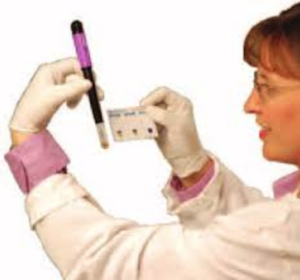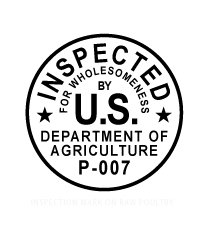Residue Testing: How is chicken tested to ensure there are no harmful residues in the meat?

The United States Department of Agriculture’s (USDA) Food Safety & Inspection Service (FSIS) places federal inspectors in every chicken processing plant to monitor the processing line to ensure all chicken is safe and meets USDA and FDA standards.
USDA has been ensuring the safety of meat and poultry since 1906, with inspectors, scientists, and experts making food safety determinations daily. FSIS has a rigorous drug residue testing program and has been conducting drug residue testing since 1958.
When FSIS tests for residues, USDA inspectors collect meat and poultry samples at multiple points in the process, including in the final packages, before they are shipped to grocery stores. The samples are sent to FSIS labs, where they test for more than 200 veterinary drug and chemical residues as well as numerous harmful pathogens. Their intensive testing process includes a preliminary test, or screening test, followed, when positive, by confirmatory testing. The screening instrument very often produces a response, which is why the agency completes the screening process, using controls and other evidence, to determine if the responses are confirmed and reproducible.
- The U.S. National Residue Program for Meat, Poultry, and Egg Products, administered by FSIS, is an interagency program designed to identify, rank, and analyze for chemical contaminants in meat, poultry, and egg products.
- FSIS randomly samples poultry meat at slaughter and tests for residues of more than 200 drugs, antibiotics, chemical contaminants, and pesticides. FSIS tests the samples from chickens against tolerance levels set by the FDA.
- FSIS uses analytical methods to detect, identify, and quantify residues that may be present in the samples.
- Data from this monitoring program shows an extremely low percentage of residue violations.
- Chicken consistently has the safest record of any meat product tested for residues by USDA.

What happens if harmful residues are found in the chicken that is tested?
- If a sample violates the FDA tolerance level, up to 100% of animals from that supplier may be tested by FSIS. Tests proceed for four consecutive and separate shipments until all shipments from the supplier are negative.
- In the meantime, the supplier’s failure to prevent animals with violative residues from entering the establishment is documented and all chicken from that supplier is halted from entering the market.
What about antibiotic residues in chicken meat? I’ve seen labels on chicken packages that say, “Antibiotic Free” or “No Antibiotics Ever.”
This is in reference to no antibiotics being administered during the life of the chicken. It has nothing to do with antibiotics being present in the meat itself. There seems to be a widespread misconception that when people eat meat from chickens that have been treated with antibiotics, they are also consuming the medicine with which they were treated. In reality, there are multiple safeguards in place to ensure safety.
- FDA-approved antibiotics are only used in chicken production to treat and prevent specific diseases, under the prescription of a licensed veterinarian.
- Before an antibiotic is approved for use in chickens and other food animals, extensive studies determine how long antibiotics take to leave an animal’s system.
- By law, animals given an antibiotic cannot be processed until the “withdrawal period” ends to ensure the antibiotic has left the animal’s body. This is verified by FSIS and processors’ routine testing of chicken meat before it leaves the processing plant to ensure there are no unsafe residues.
- For more information about antibiotic use in raising chickens, click here.
Are there other drug residues in my chicken that I should be concerned about? I read the Consumer Reports article that mentioned drugs like ketamine, phenylbutazone, chloramphenicol, and nitroimidazoles residues in meat and poultry.
- This is verified by the FSIS and processors’ routine testing of chicken meat before it leaves the processing plant to ensure there are no unsafe residues. The final validated results of the data that Consumer Reports is relying on published in the 2016 USDA Residue Sample Result Report – publically available on the USDA website – shows there were zero positive violative samples for chicken products during this time.
- None of these drugs – ketamine, phenylbutazone, chloramphenicol, and nitroimidazoles – have ever been approved or used in raising broiler chickens in the United States.
- Only confirmed test results using a validated testing method can be used to make claims and/or accusations, as anyone with a scientific background would confirm. Assumptions based on unconfirmed tests or preliminary false positives are scientifically unjustified and would amount to fear mongering and needless alarm.
- As Consumer Reports clearly states in this article, “The concerns raised in this investigation does not mean you should give up or necessarily cut back on meat. The findings are too uncertain and the potential risks unknown.”
What are these drugs used for?
- Ketamine is a medication mainly used in humans for starting and maintaining anesthesia. It induces a trance-like state while providing pain relief, sedation, and memory loss. Other uses include for chronic pain and for sedation in intensive care. It is not and has never been used in raising chickens.
- Phenylbutazone is a nonsteroidal anti-inflammatory drug for the short-term treatment of pain and fever in horses and dogs. It has no human use and is not and has never been used in raising chickens.
- Chloramphenicol is an antibiotic useful for the treatment of a number of bacterial infections in humans, including as an eye ointment to treat conjunctivitis. It is not and has never been used in raising chickens. Its use in veterinary medicine is highly restricted and they are not nor have they ever been used in raising chickens.
- Nitroimidazole antibiotics have been used to combat anaerobic bacterial and parasitic infections, mostly in dogs, cats, and other companion animals and for the management of chronic inflammatory bowel disease in cats and dogs. Another common usage is the treatment of systemic and/or gastrointestinal infections in horses. In humans, it is used either alone or with other antibiotics to treat pelvic inflammatory diseases. It is not and has never been used in raising chickens.
So if ketamine, phenylbutazone, chloramphenicol, and nitroimidazoles aren’t used in meat and poultry production, how are residues, even trace amounts being detected in meat and poultry?
- Again, in most cases these are preliminary screening data and not confirmed tests.
- Testing methods and technology today are so sophisticated and sensitive that you can find trace amounts of just about anything anywhere. This is what scientists refer to as “background noise.”
- A lot of these chemicals occur naturally in the environment.
I’ve heard there are trace amounts of other certain residues (like arsenic and chlorine) in my chicken, is that true?
For more information about arsenic specifically, click here. For more information about chlorine use in chicken processing, click here.
